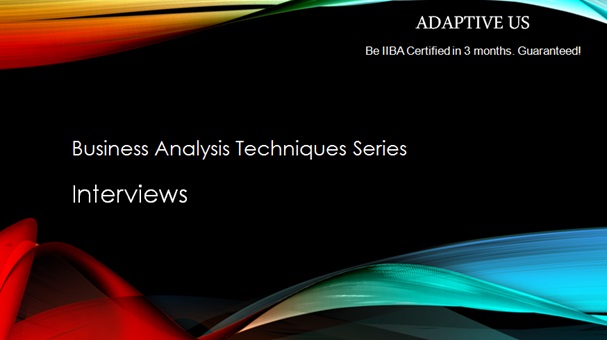If someone asks you what the World’s most preferred elicitation technique is, I trust most of you will be able to answer it. It is interviews.
Interviews have been used for ages by business analyst to collect business analysis information from stakeholders. In this blog, let us talk about a fundamental technique for business analysts: interviews.
Interviews are the most common form of elicitation technique where interviewers ask questions to stakeholders. Effective interviewers control discussions. They understand the needs of ALL stakeholders, probe deeper when needed, and ensure the completeness of answers.
Interviews are of two types-structured and unstructured. In the structured interview, a predefined set of questions are asked by the interviewer, whereas questions vary based on interview responses and reactions in the unstructured interview, as we saw in this example. In addition, interview questions can be classified into two-open ended, which typically initiate closed questions, and a dialog, which elicits a single response like yes or no, or a specific number.
Although interviews encourage stakeholder participation and establish rapport, planning and conducting interviews takes significant time.
The success of requirements interviews depends on:
Interviewer skills
- Domain understanding,
- Documentation skills,
- Experience and willingness.
Interviewee skills
- Readiness to provide relevant information,
- Clarity about interview goal,
- Rapport between interviewer and interviewee.
Steps to conduct requirements interviews:
- Define interview goal:
Consider the business need and goals for each interview.
Identify potential interviewees: Along with PM, sponsors, and other stakeholders, based on interview goal. Communicate interview goals clearly to interviewees.
Design interview questions: Based on interview goals, such as data collection, research stakeholder’s views of change, or proposed solution, develops a proposed solution or build rapport with interviewees.
Use open-ended questions to encourage description, which encourages thinking. Business analysts use closed questions to elicit a single response, such as yes, no, or a specific number. Closed questions clarify or confirm a previous answer.
Organize interview questions based on priority and significance. For example, order questions in a flow such as general to specific, start to finish, and summary to detailed, interviewee’s level of knowledge and subject of the interview.
- Organize logistics:
Decide location and mode of communication (in-person, phone, or online conferencing), recording needs, etc. Then, send questions in advance ONLY when the interviewee needs to collect information to prepare for the interview.
- Conduct interview
Opening:
- Describe purpose,
- Confirm interviewees’ roles,
- Address any initial concerns raised by interviewees,
- Explain how information from the interview will be recorded and shared with various stakeholders.
During interview
- Maintain focus on interview goals and predefined questions,
- Adapt based on information provided and non-verbal clues,
- Provide required information,
- Manage concerns raised by addressing them during the interview or documenting them for follow-up,
- Practice active listening,
- Record discussions.
Closing interview includes:
- Ensure no areas are overlooked.
- Provide contact information to follow up with additional information.
- Summarize session.
- Considers multiple sessions if needed.
- Thank interviewees for their time.
- Follow-up
Organize interview information and confirm results quickly.
Strengths
- Encourages participation.
- Builds rapport with stakeholders.
- simple and direct technique.
- Allows observations of non-verbal behavior.
- Allows follow-up and probing questions.
- Interviewees express opinions that they may not do in public.
Limitations
- Needs significant time.
- Needs commitment and involvement of participants.
- Needs trained facilitator.
- subject to interviewer’s interpretation.
- Unintentionally leading the interviewee.
Example:
Let us learn how to carry out an interview with the help of an example. Governance, Risk, and Compliance (GRC) management system are developed for the IT and ITES domain. The main objective of the GRC management system is to assist companies in applying Governance, Quality, and Information Security Management Systems in an integrated manner. It has numerous features, one of which is to plan and track programs and projects using standards such as CMMI, ISO 9001, ISO 27001, etc.
Through this example, let us understand how a BA discusses the requirement of project schedule management with the Project Manager, a key stakeholder in the Governance, Risk, and Compliance (GRC) management system.
Abstract of a discussion between the BA and Project Manager
Michelle (BA): Good morning, Dinesh. Thanks for taking some time out to talk to me.
Dave (PM-Dev Projects): Good morning, Michelle.
Michelle: Congratulations on receiving the prestigious Deloitte Technology Fast 50 Award.
Dave: Thanks, Michelle. Yes, indeed, it is excellent news for our organization.
Michelle: As I had intimated to you earlier, I am appointed for the role of Lead BA for the project governance system for the company. I met Mike last week to collect the high-level business requirements for the project governance system. Mike wanted me to meet you to get an understanding of the system requirements for the schedule management module.
Dave: Sure, Michelle. I can give you the requirements for development projects since I manage development projects. For other types of projects, please have a talk with Lily, Srini, and Abdullah.
Michelle: Can you pls. Describe how schedule management is currently performed in our organization?
Dave: During the proposal preparation phase, a rough schedule with high-level milestones is provided by our solutioning team to the client. Once the contract is given to us, the same details are given to the Project Managers. As a result, project managers expand the schedule.
Michelle: I am happy to know about the process, Dave. Can you share the template used by the Solutioning team for the same?
Dave: The data captured is quite simple. The Engagement Managers and Sales Managers fill up the following table.
| Milestone Name | Planned Start Week | Planned End Week | Responsible |
Michelle: Are there any business rules to be followed while creating this data?
Dave: Not very sure, Michelle. This is created by the Solutions team. We gave them our past data, and later it was reviewed by the Senior Management for appropriateness.
Michelle: Thanks, Dave. How do you expand the schedule?
Dave: This is highly non-standardized at this point in time, and that’s what makes our projects vulnerable to failure. Each project manager expands the task list based on his/her prior experiences.
Michelle: I have taken note of that, Dave. Would you like our new project governance system to formalize the process?
Dave: That will be a great thing! It will reduce our work and the chances of failure. I know from my personal experiences that many projects have suffered heavily because the project manager forgot to include performance or security testing.
Michelle: In the expanded schedule, do you capture any other information?
Dave: Yes, Michelle. The expanded schedule has planned, re-planned and actual start and end dates, efforts, and resource names
Michelle: Ok, Dave. Is there any current template that you use?
Dave: I have created an excel based template that business analysts use for my projects. Being it an excel based template, it is difficult to share with all team members. Especially collecting actual efforts becomes very hard as I am consolidating 40+ excel workbooks each week.
Michelle: Thanks for the information, Dave. I will assemble the requirements for the effort tracking system later. However, I am noticing that our schedule module will require integration with the effort capture system and even with our attendance tracking system.
Dave: Okay, Michelle.
Michelle: Are there any particular rules that we need to follow for schedule management?
Dave: Of course, Michelle. Since tasks can have a hierarchy, the child elements must be contained with parent elements. End dates can never be prior to starting dates.
Michelle: Are there any particular interfaces that you would like to have scheduled?
Dave: Yes, Michelle. As most of our planning may happen in MS-Project or MS-Excel, it is better for the system to have a feature for importing and exporting tasks from MS-Project and MS-Excel.
Michelle: What are the reports that you are expecting from the system?
Dave: We need reports on task-wise schedule variance and effort variance. This is a very key report for customers and for our senior management.
Michelle: Okay, Dave. Let me make a note of that. Would you like to explain any other critical feature from your perspective?
Dave: We also would need caution for task allocation and escalation for tasks delayed more than a week.
Michelle: Anything else, Dave?
Dave: No, Michelle. I am done from my side.
Michelle: Thanks, Dave, for your time, and I hope we complete the project soon.
Dave: Thanks, Michelle. See you again with the solution.
From this example, we understand that there is no formal and standard way of capturing the schedule at present. The schedule is followed by means of spreadsheets which become cumbersome over time. The Lead BA has also captured business rules and functional requirements.
Thus, the interview is a commonly used technique for eliciting requirements. It is a systematic approach to eliciting the required information by asking relevant questions and making a note of the responses. This is a wonderful technique to build trust and involve stakeholders in the initiative.
About Adaptive US
Adaptive US is the World’s #1 Provider of IIBA Certifications Courses and Study Aids on CBAP, CCBA, ECBA, CBDA, CPOA, AAC, and CCA. It is the ONLY training institute to offer a 100% Success Guarantee or 100% Refund promise for all IIBA certifications Instructor-Led Training. It also provides skill-based training to business analysts on business analysis tools and templates.







